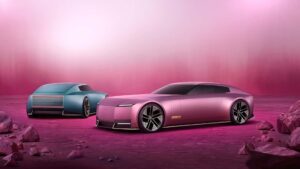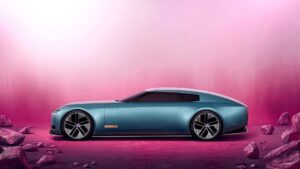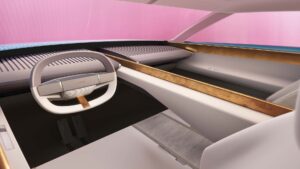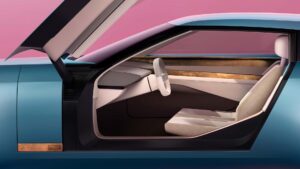
Jaguar’s path towards an electric future is clear after the dramatic reveal of the Type 00 concept car at Miami Art Week.
Following weeks of debate surrounding its rebranding efforts, Jaguar hopes the Type 00 will shift focus back to its electric ambitions.
The Type 00 previews a four-door GT due next summer, before deliveries begin in late 2026. The name, pronounced “type-zero-zero,” combines Jaguar’s heritage with a double-zero to signify a brand reset and zero-emission future.
“Type 00 is the first lines ever drawn for new Jaguar – its origin story,” said managing director Rawdon Glover. The concept features a striking design with a blunt front, long bonnet, sweeping roofline, fastback profile, and muscular rear arches. Jaguar’s new multi-line strikethrough design element is prominent on the front, rear, bonnet, roof, and dashboard.
Similar to previously leaked photos of a disguised production car, the Type 00 forgoes a rear window for the tailgate, likely hinting at the use of pop-out cameras instead of a traditional rear view mirror.
The development car, however, has conventional wing mirrors. The rear features a full-width taillight housed within the strikethrough design element, sitting between the wide arches.
The stripped-back interior, accessed via rising “butterfly” doors, boasts a 3.2-meter brass spine separating the two large digital screens. These screens can be folded away for a “digital detox,” with key driver information displayed on a slender screen along the base of the windscreen.
“The past decade has seen Jaguar pursue a mass-volume strategy and the cars have not been distinctive enough,” said Jaguar Land Rover chief executive Adrian Mardell. “This is the time to do something special.”
Jaguar Land Rover chief creative officer Gerry McGovern added: “We don’t want to appeal to everyone; this car will shock. It will take Jaguar back to its roots, a brand loved for its uniqueness. We needed to create something jaw-dropping and never seen before.”
While the two-seat coupe concept won’t make production, Jaguar claims it shares clear design cues with the four-seat GT, including the long bonnet and blunt front.
“Type 00 is a clear illustration of what you can expect; its exuberant properties will be shared with all future Jaguars,” continued Glover. “The proportionality is really important; in an era where all EVs are cab-forward and all about aero, we’ve created a vehicle that has real presence and exuberant, long-bonnet proportions. It’s low-riding when everyone else is quite high because of their battery stack, and while everyone is focusing on tiny wheels to get the range, we said that’s not right for us – we need presence and drama.”
Jaguar remains tight-lipped about the concept’s technical aspects, particularly battery placement in such a low-slung car. The production GT will be built on the new Jaguar Electric Architecture (JEA), which will also underpin two more models by 2028, likely a large SUV and a luxury saloon.
The GT is estimated to cost around £225,000 with a targeted range of 770 km (478 miles) and charging capability to add 200 miles in 15 minutes. Despite the slow adoption rate of electric cars, Jaguar has reaffirmed its commitment to a future free of hybrids or petrol engines.














